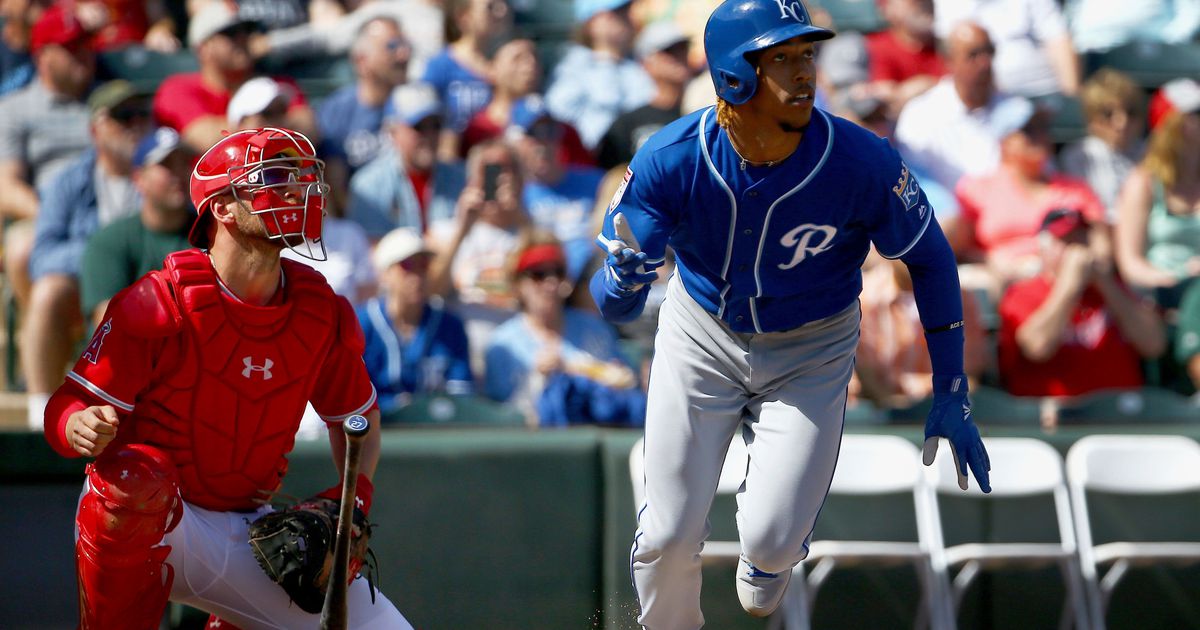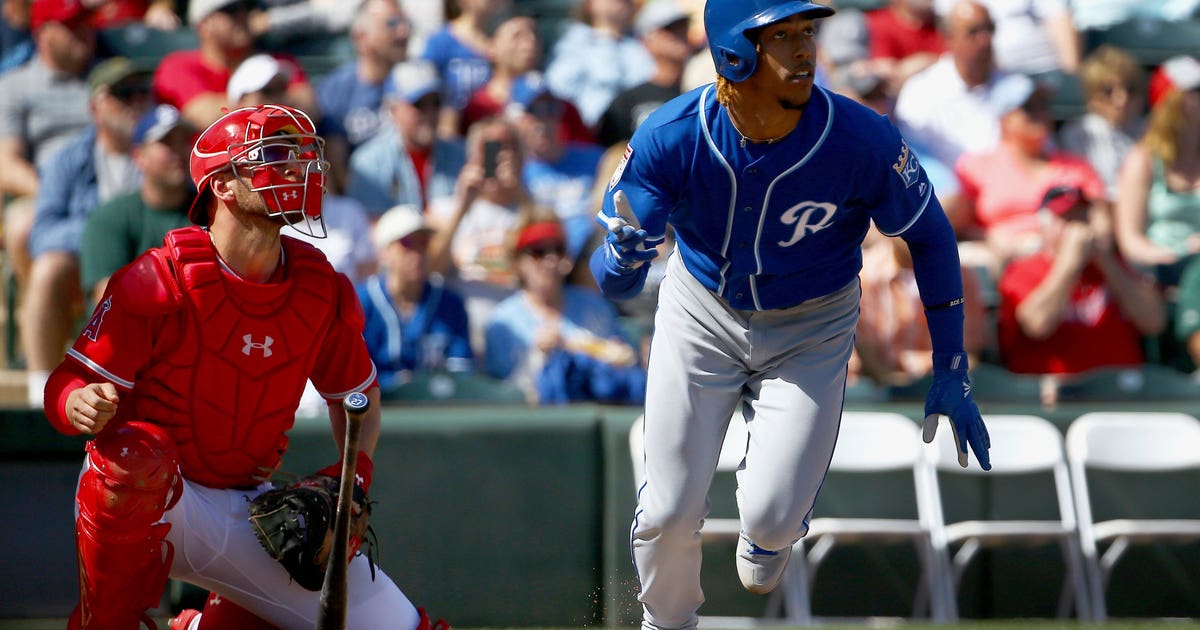Speed: A novel concept in today’s MLB, a strategic imperative for Royals


SURPRISE, Ariz. — Brett Phillips has always been the fastest player on his team, whether he was playing in Little League, starring at Seminole High School or climbing the rungs of the minor league ladder.
When he looks around the Kansas City Royals’ clubhouse, though, the fleet-footed outfielder was left to ask a very sobering and sincere question: “What am I, the 10th fastest now?”
Not quite. But just about.
You see, the Royals identified a market inefficiency a few years ago when it came to bullpen arms, stockpiling huge talents at low costs and effectively shortening games. The result was twofold: They won back-to-back American League pennants and the 2015 World Series, and every other team noticed what they had done and began to offer big contracts to premier relievers.
Unable to keep up with those escalating costs, the Royals turned their attention to speed and defense as they dive headlong into a rebuild. Now, they view stolen bases as grossly undervalued in an era of power hitters, and they have built quite possibly the fastest lineup in baseball.
Second baseman Whit Merrifield led the majors with 45 steals last season. Billy Hamilton, who signed with Kansas City as a free agent, was fifth with 34. Young shortstop Adalberto Mondesi had 32 steals despite getting just 275 at-bats after a midseason call-up.
Whit is loving the speed in this @Royals lineup: “It’s going to make for some exciting games in Kansas City. We’re gonna be an electric team.” #Royals pic.twitter.com/QM9l43pWuU
— FOX Sports Kansas City (@FSKansasCity) March 4, 2019
That’s three of the top eight in the big leagues last season, and doesn’t even factor in Phillips, free-agent signing Chris Owings or speedsters Brian Goodwin and Terrance Gore.
“We felt we needed to improve, and speed and defense were two areas where we could improve,” said general manager Dayton Moore, the architect of both the World Series title team and now the reboot.
“It could make a difference,” he explained. “It could force teams to prepare for us. We could have an identity, a team that plays really, really hard, fundamentally sound, impactful defense and speed that cannot be defended. That was our mindset.”
It’s a mindset that runs counter to every trend in baseball.
There was a yearly average of more than 3,000 steals throughout the 1990s, even with a strike-shortened 1994 season. But the number has declined each of the past four seasons, and the 2,474 steals last year were a drop of nearly 800 from 2012 and the lowest total in a non-shortened season since 1973 — when there were six fewer teams.
Ricky Henderson stole 130 bases for Oakland in 1982. Lou Brock swiped 118 for St. Louis in 1974. Vince Coleman surpassed 100 for the Cardinals in three consecutive seasons from 1986-88.
Only six TEAMS surpassed 100 steals last season.
There are several reasons for the abrupt downturn. Managers generally loathe the idea of running into an out on the basepaths, and fans dig the instant offense of home runs. Then there are advanced analytics that have changed the complexion of baseball, and that suggest a player must be successful on 75 percent of steals to balance the risk of making a precious out.
“The game has changed to the point where, for me, the game is a little boring,” Royals manager Ned Yost said. “You can have the debates on the shift — I don’t like the shift. It takes away offense. It takes away singles. Singles are dwindling in our game. Guys are more focused on raring back and swinging as hard as they can to hit home runs. That results in higher strikeouts and more home runs.
“But I like strategy in the game. I like singles,” Yost said. “I don’t care if you bunt. I don’t care if you walk. I like runners moving. I like to put runners in motion. I like stealing.”
He’s not the only one, either.
The Mariners acquired Dee Gordon in a trade with the Marlins and Mallex Smith in a trade with the Rays, giving them two leading base-stealers. Nationals skipper Dave Martinez said recently that speedy outfielder Trea Turner has the green light whenever he’s on base.
“We let the reins go,” Martinez said. “I kind of put the pressure on him a little bit about maybe having more attempts. If you look at the best baserunners to ever play the game, those guys had 90 to 100 attempts every year, and last year he had 52 and he stole 43 bases. So we want him to go more, and I think the more he goes, the more he’ll steal.”
Still, nobody values speed like the Royals. They lavished Merrifield with a four-year, $16.25 million contract this past offseason. They gave Hamilton $5.25 million for this year. And they traded for Phillips, landed Owings and suddenly have quite the 4×400 relay team.
Moore on signing Billy Hamilton and adding to the @Royals‘ speed: “The type of player we covet and we desire was available so we were very aggressive. … We can’t have enough of that type of talent on the field.” #Royals pic.twitter.com/HayqE14Lg8
— FOX Sports Kansas City (@FSKansasCity) March 4, 2019
“I’d probably weight them down. We’ve got some pretty athletic dudes,” said Royals pitcher Danny Duffy, quick to point out the benefits of that speed from an opposing perspective.
Pitchers have to be more wary of bunts. They have to be cognizant of holding guys on base. They have to know that anything in the gap could score a run from first, and that those fleet-footed speed freaks are willing to grab an extra bag whenever the opportunity arises.
Still, the amount of money the Royals invested in their quick-twitch approach pales in comparison to the money other clubs have spent on power, and that is where the market inefficiency lies.
Just this offseason, Bryce Harper signed a $325 million deal with Philadelphia and Manny Machado inked a $300 million contract with San Diego. Other big contracts in recent years have gone to other big sluggers, whether it was Albert Pujols ($240 million with the Angels), Prince Fielder ($214 million with Detroit) or Jason Heyward ($184 million with the Cubs).
The small-market Royals have never given out a contract that even approaches those deals, and the reality is they probably never will. But with a unique approach, they believe they don’t have to.
In essence, they believe their speed will pay off just as much.
“I know that’s been the hot topic, that these guys are fast,” Phillips marveled during the early days of Royals spring training. “I like to think I’m fast, but when you put me next to these guys, I’m slow. But that’s what you want as a team. Our purpose is getting on base and scoring runs.”







